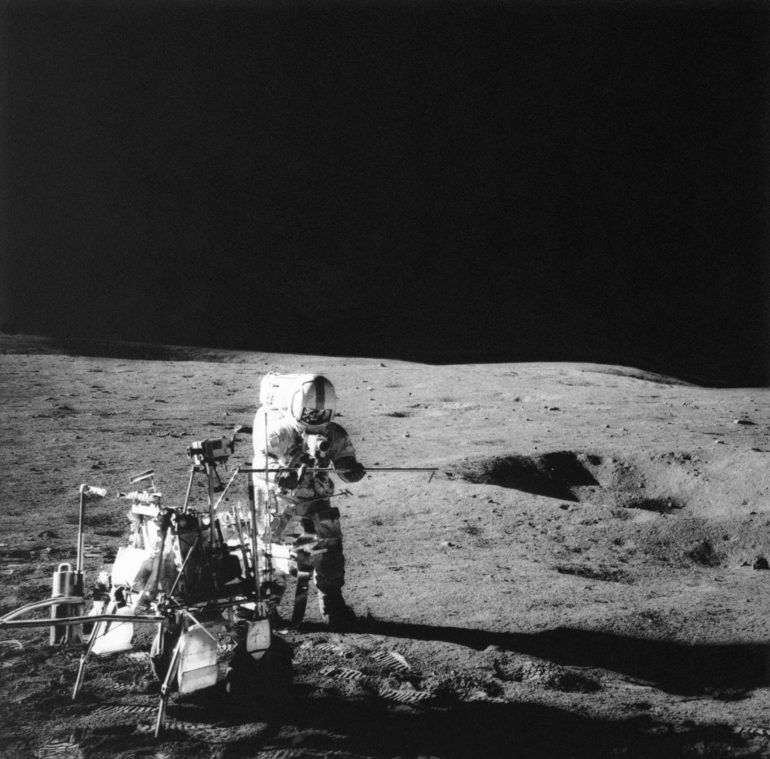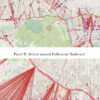Fifty years later, it remains the most impressive bunker shot in the history of golf, mainly because of the location.
The moon.
Apollo 14 commander Alan Shepard and his crew brought back about 90 pounds of moon rocks on Feb. 6, 1971. Left behind were two golf balls that Shepard, who later described the moon’s surface as “one big sand trap,” hit with a makeshift 6-iron to become a footnote in history.
Francis Ouimet put golf on the front page of American newspapers by winning the 1913 U.S. Open. Gene Sarazen put the Masters on the map by holing a 235-yard shot for an albatross in the final round of his 1935 victory.
Shepard outdid them all. He put golf in outer space.
“He might have put golf on the moon map,” Jack Nicklaus said this week. “I thought it was unique for the game of golf that Shepard thought so much about the game that he would take a golf club to the moon and hit a shot.”
Shepard became the first American in space in 1961 as one of NASA’s seven original Mercury astronauts. After being sidelined for years by an inner ear problem he became the fifth astronaut to walk on the moon as Apollo 14 commander.
But he did more than just walk the moon.
Shepard waited until the end of the mission before he surprised American viewers and all but a few at NASA who did not know what Shepard had up his sleeve—or in this case, up his socks. That’s how he got the golf gear in space.
“Houston, you might recognize what I have in my hand as the contingency sample return; it just so happens to have a genuine 6-iron on the bottom of it,” Shepard said. “In my left hand, I have a little white pellet that’s familiar to millions of Americans.”
He hit more moon than ball on his first two attempts. The third he later referred to as a shank. And he caught the last one flush, or as flush as an astronaut can hit a golf ball while swinging with one hand in a pressurized spacesuit that weighs 180 pounds (on Earth).
“We used to say it was the longest shot in the history of the world because it hasn’t come down yet,” famed golf instructor Butch Harmon said with a laugh.
Harmon is loosely connected with the shot through his relationship with Jack Harden Sr., the former head pro at River Oaks Country Club in Houston whom Shepard asked to build him a 6-iron he could take to the moon. Harden managed to attach the head of a Wilson Staff Dyna-Power 6-iron to a collapsible tool used to collect lunar samples.
The shots did come down on the moon. Still up for debate is how far they went.
“Miles and miles and miles,” Shepard said in a light moment that was broadcast in color to a captive television audience watching from nearly 240,000 miles away.
Not quite. The shot for years has been estimated at 200 yards, remarkable considering how much the bulk of his spacesuit restricted Shepard’s movement. He had even practiced in his spacesuit in a bunker in Houston when no one was around.
On occasion of the 50-year anniversary, British-based imaging specialist Andy Saunders provided a more accurate account. Saunders, who is working on a book called, “Apollo Remastered,” worked out through digital enhancing and stacking techniques of video footage that the first shot went 24 yards. The second ball went 40 yards.
Former PGA champion Jimmy Walker hits a 6-iron about 200 yards on Earth. Walker, a space enthusiast with a skill and passion for astrophotography, worked with the USGA and Saunders as the Apollo 14 anniversary neared to see how far he could hit a 6-iron in one-sixth gravity of the moon.
“He was known for saying miles and miles,” Walker said. “They took my launch conditions and said my ball would fly 4,600 yards and it would have just over a minute of hang time.”
That would be a little over 2 1/2 miles.
That also would be a conventional 6-iron while wearing golf shoes and a sweater vest.
What stands out all these years later is Shepard even thinking about taking a golf club to the moon and back. The inspiration came from Bob Hope, who carried a golf club just about everywhere he went. That included a trip to Manned Spacecraft Center in Houston a year before the Apollo 14 mission.
According to USGA historian Michael Trostel, that’s what made Shepard realize a golf shot would be the ideal illustration of the moon’s gravitational pull. To build a club, he found the right person in Harden at River Oaks.
“He was incessant tinkerer with equipment,” said Brandel Chamblee, a Golf Channel analyst and longtime friend of Harden’s son. “I would tease Jack and his father, any club they got had been ‘Hardenized.’ No club off the rack was ever good enough for them. They always changed the lie, the loft, the bounce. They used lead tape. It was apropos he made Shepard’s 6-iron.”
Convincing his superiors took some doing. In a 1998 interview with NASA, Shepard said he ran his idea by the director of the Manned Spaceflight Center who told him, “Absolutely no way.” Shepard told him club and two golf balls wouldn’t cost the taxpayers anything. And he would only do it if the entire mission was a complete success.
Shepard said he told director Bob Gilruth, “I will not be so frivolous. I want to wait until the very end of the mission, stand in front of the television camera, whack these golf balls with this makeshift club, fold it up, stick it in my pocket, climb up the ladder, and close the door, and we’ve gone.”
The actual club is one of the prize exhibits at the USGA Museum in New Jersey, which came with one awkward moment.
“He donates it at a ceremony at the 1974 U.S. Open,” Trostel said. “NASA called him later and said it was looking at the club for the Smithsonian. He said he already had donated it to the USGA Museum. They said, ‘Mr. Shepard, that’s government property.’ We had a replica commissioned and gave it to the Smithsonian National Air and Space Museum.”
For years, no one knew what golf balls he used and Shepard was determined to avoid any commercialism. Chamblee and Harmon unlocked the mystery this week, and it came with a twist.
They were range balls from River Oaks.
“Within the Hardens, the legacy is he gave him golf balls from the range that had ‘Property of Jack Harden’ on them,” Chamblee said. “Technically—if the balls aren’t melted—Jack is the only person who owns property on the moon.”
All because of a one-handed swing by Shepard, still the only person to hit a golf ball on the moon.
“It was designed to be a fun thing,” Shepard said in the 1998 interview, five months before his death at age 74. “Fortunately, it is still a fun thing.”
Blue Origin launches capsule to space with astronaut perks
2021 The Associated Press. All rights reserved. This material may not be published, broadcast, rewritten or redistributed without permission.
Citation:
Out of this world: Shepard put golf on moon 50 years ago (2021, February 5)
retrieved 5 February 2021
from https://phys.org/news/2021-02-world-shepard-golf-moon-years.html
This document is subject to copyright. Apart from any fair dealing for the purpose of private study or research, no
part may be reproduced without the written permission. The content is provided for information purposes only.



